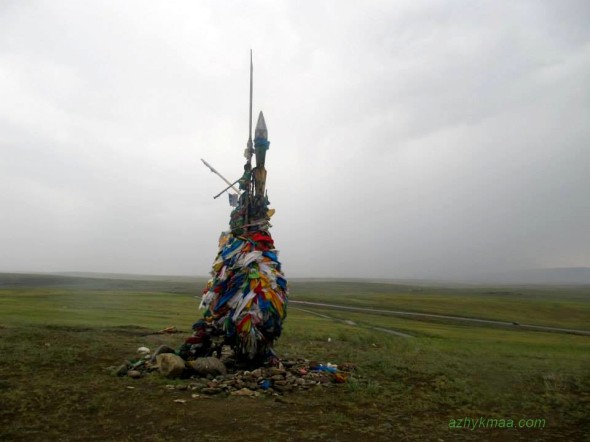WHAT İS “OBOO” ?
Mountain spirits and other powerful gazriin ezen spirits are worshiped at special shrines called oboo, which are tall piles of rocks and tree branches. An oboo is roughly conical in shape, about 6-10 feet tall. When passing by an oboo travelers are required to walk around it three times and place a rock on it. In doing this not only is a person showing respect for the spirit, which would be the least required of him, but in symbolically by adding to the spirit’s power by adding the rock he is receiving windhorse and good luck for his journey. In order to get more windhorse (hiimori) and buyanhishig a person might also make and offering of liquor, milk, or butter. Sometimes car parts will be hung from the tree branches to assure that there will be no brakedowns.
Oboo are also the sites of several ceremonies during the year that nearby families or clans would celebrate in honor of the local spirit as well as Father Heaven and Mother Earth and other shamanist spirits. During the celebration of the lunar New Year, or White Moon (Tsagaan Sar), an oboo is made of snow and offerings are made to Father Heaven. Nearby a fire is built that is not allowed to go out for a month; this fire is called Tengeriin oboo (oboo of Father Heaven). Oboos not only represent mountains, but by their upward pointing nature they also represent a point of closer contact between heaven and earth, just as a mountain top is considered to be closer to Tenger and therefore spiritually powerful.
In Mongolia and Siberia certain mountains and mountain ranges are considered especially sacred. One of the most famous is Burhan Haldun, which lies in the region where Chinggis Khaan was born. It has been sacred since prehistoric times, and burial sites for shamans dot it’s slopes. The Altai Mountains in Mongolia, Tuva, and southern Siberia are considered sacred, and the spirit of the Altai is known as Altai Aab (Father Altai). When shamans in the Altai region travel to visit the clan spirit, they may first travel to the ger of Altai Aab to pay respects. The Sayan Mountains on the border of Buryatia, Mongolia, and Tuva are home to several powerful spirits, and a special type of shaman, the hadaasha, performs rituals to honor these spirits. The thirty-three baatar of Bukhe Biligte Tenger in the Tunken Valley of the Sayan Mountains are an especially important family of spirits. The capital of Mongolia, Ulaan Baatar, was founded at it’s present site almost 400 years ago because of it’s location in a spiritually powerful spot. It lies in a circular valley surrounded by four holy mountains that are revered throughout Mongolia. The four mountains include the Bogd Uul (literally, “Holy Mountain”) to the south, Songino Hairhan to the west, Chinggeltei to the north, and Bayanzurh to the east. Of these, the southern and western mountains are especially interesting. The Bogd Uul is the home of the thunderbird Han garid, a huge bird that can cover the sun and moon with it’s wings and fly into outer space. Songino Hairhan is the home of the spirit of the shaman Songino, who is said to have lived at the time of the founding of Ulaan Baatar. The siting of this city in a circle among four holy mountains located in each of the four directions ensured it’s protections and blessings from all the spirits residing in such a spiritually powerful place.
Read more : Sacred Mountains and Trees





